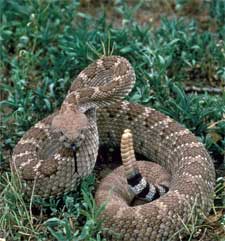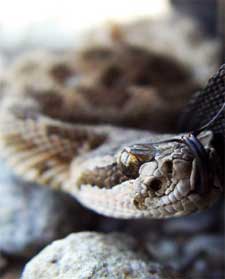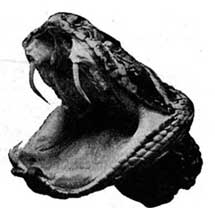|

 Shake, RATTLE, and roll: The rattle is composed of a series of nested, hollow beads which
are actually modified scales from the tail tip. Each time the snake
sheds its skin, a new rattle segment is added. Since they may shed
their skins several times a year depending on food supply and growth
rates and since the rattle can and does break, there is little truth
to the claim that one can tell a rattlesnake's age from the number
of beads in its rattle. Newborn rattlesnakes do not have functional
rattles; it isn't until after they have shed their skin for the
first time that they gain an additional bead, which beats against
the first bead, known as the button, to create the rattling sound.
Adult snakes may lose their rattles on occasion, but more appear
at each molting. In wet weather if the rattle has absorbed sufficient
water, it will not make noise. Shake, RATTLE, and roll: The rattle is composed of a series of nested, hollow beads which
are actually modified scales from the tail tip. Each time the snake
sheds its skin, a new rattle segment is added. Since they may shed
their skins several times a year depending on food supply and growth
rates and since the rattle can and does break, there is little truth
to the claim that one can tell a rattlesnake's age from the number
of beads in its rattle. Newborn rattlesnakes do not have functional
rattles; it isn't until after they have shed their skin for the
first time that they gain an additional bead, which beats against
the first bead, known as the button, to create the rattling sound.
Adult snakes may lose their rattles on occasion, but more appear
at each molting. In wet weather if the rattle has absorbed sufficient
water, it will not make noise.
Some discretion, please: Even with a useful rattle, a rattlesnake might not always give
warning. Some speculate that rattlesnakes that use their rattles
around humans are often killed and natural selection may favor rattlesnakes
that do not give advance warning.
 Startled Snake!: Different species of rattlesnake vary significantly in size, territory,
markings, and temperament. If the rattlesnake is not cornered or
imminently threatened, it will usually attempt to flee from encounters
with humans, but will not always do so. Bites often occur when humans
startle the snake or provoke it. Those bitten while provoking rattlesnakes
have usually underestimated the range and speed with which a coiled
snake can strike. Heavy boots and long pants reinforced with leather
or canvas are recommended when hiking in areas known to harbor rattlesnakes. Startled Snake!: Different species of rattlesnake vary significantly in size, territory,
markings, and temperament. If the rattlesnake is not cornered or
imminently threatened, it will usually attempt to flee from encounters
with humans, but will not always do so. Bites often occur when humans
startle the snake or provoke it. Those bitten while provoking rattlesnakes
have usually underestimated the range and speed with which a coiled
snake can strike. Heavy boots and long pants reinforced with leather
or canvas are recommended when hiking in areas known to harbor rattlesnakes.
Life Lessons: For learning how to quickly and safely identify rattlesnakes by
their markings, guides are available through booksellers, libraries,
and local conservation and wildlife management agencies. The best
way to avoid contact with rattlesnakes is to remain observant and
avoid potential encounters. Hikers should always watch their steps
when negotiating fallen logs or boulders and take extra caution
when near rocky outcroppings and ledges where rattlesnakes may be
hiding or sunning themselves. Pets should be kept leashed to prevent
them from provoking a rattlesnake.

 A Venomous Mouth: Rattlesnakes are born with fully functioning fangs capable of injecting
venom and can regulate the amount of venom they inject when biting.
Generally they deliver a full dose of venom to their prey, but may
deliver less venom or none at all when biting defensively. A frightened
or injured snake may not exercise such control. Additionally, young
snakes may have not yet learned to control the amount of venom they
deliver. Some studies contest that young snakes may be capable of
injecting less venom, and the high toxicity of their bite comes
from a variation in their venom which causes it to have a more potent
concentration than in their adult counterparts. Any bite from a
rattlesnake should be considered fully venomous and those bitten
should seek medical attention immediately. A Venomous Mouth: Rattlesnakes are born with fully functioning fangs capable of injecting
venom and can regulate the amount of venom they inject when biting.
Generally they deliver a full dose of venom to their prey, but may
deliver less venom or none at all when biting defensively. A frightened
or injured snake may not exercise such control. Additionally, young
snakes may have not yet learned to control the amount of venom they
deliver. Some studies contest that young snakes may be capable of
injecting less venom, and the high toxicity of their bite comes
from a variation in their venom which causes it to have a more potent
concentration than in their adult counterparts. Any bite from a
rattlesnake should be considered fully venomous and those bitten
should seek medical attention immediately.
All text is available under the terms
of the GNU Free Documentation License
|